Are you trying to decide if you would like to do a DNA test with Ancestry? Here, you will find a complete review of Ancestry DNA’s testing service.
Whether you are still on the fence about DNA testing, or you are trying to decide between companies, this post will provide you with solid explanations and trustworthy information to help you make your decision.
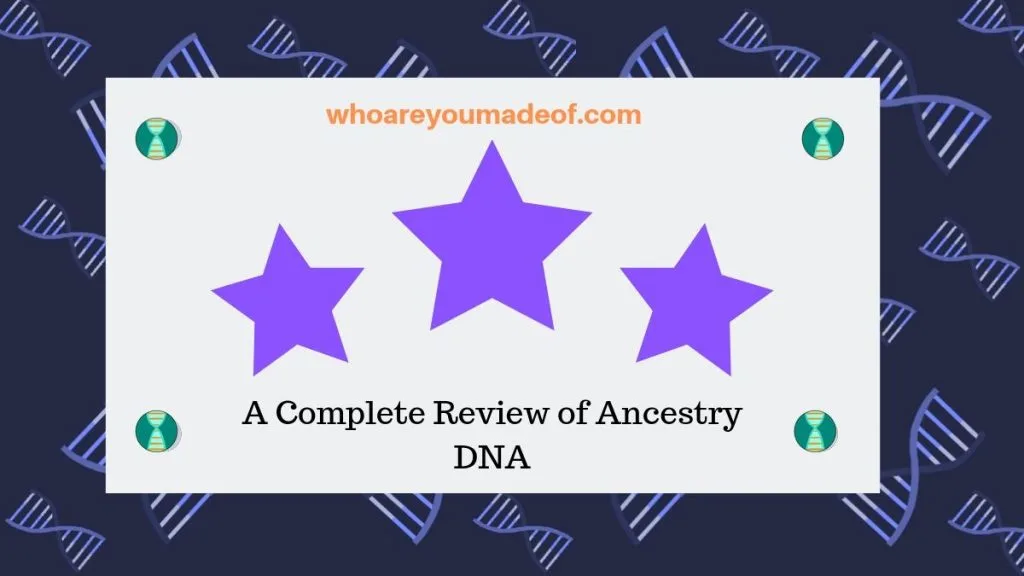
I first did my test with Ancestry DNA back in 2015. My husband and I were interested in learning about ethnicity, since we were both curious about certain physical traits that were found in our families.
Since then, I have tested with other DNA testing companies, had my results transferred to others still, and have spent an incredible amount of time analyzing my Ancestry DNA results. This puts me in a great position to show you what I have learned, what you might expect from your Ancestry DNA results, and even to explain some of the disadvantages of testing with Ancestry.
I should explain that I am not associated with Ancestry or any other DNA testing company, except as an affiliate. This means that if you click on certain Ancestry links on my website, there is a chance that I will receive a small commission if you purchase a DNA kit.
I am also an affiliate for three other DNA testing companies, and I try to explain all of the services fairly and accurately so that way you can make the best choice for your unique situation. This also provides incentive for me to not be biased towards a particular company because of potential financial gain.
A complete and honest review of Ancestry DNA
As I mentioned before, my husband and I were interested in DNA testing because of a few physical traits that we had noticed in our families. My husband is from an indigenous village in Mexico, and he grew up speaking Nahuatl with his adoptive parents.
Yet, he is much taller than many of the men in his town, and when his beard grows out, he has many noticeable red hairs. In my own family, we had the classic (cringe-worthy) theory that my grandmother’s deep colonial US roots had at one point intermingled with those of Native Americans, which somehow might explain her skin tone and long, beautiful, dark hair for which she was teased while growing up.
So, the mystery that we wanted to solve, summarized, was:
- Why does my husband have red hairs when his beard grows out, and why is he taller than most people where he is from
- Did I have a small amount of Native American in my DNA, which would explain my father and grandmother’s looks?
We will delve deep into how effectively Ancestry DNA helped us get the answer to our burning questions. I’m sure that you have your own questions about family history, and so I think it’s great to really understand how much Ancestry DNA can help you learn, and where the limitations are.
What does the Ancestry DNA test promise?
Ancestry DNA has changed a lot since the Spring of 2015 when my husband and I first tested, but there is one thing that has remained relatively similar. In the company’s advertising, it is clear that they believe that they can tell us “what we are”, just based on a DNA sample.
The image below is some text from their website a while back. AncestryDNA now compares your DNA to more than 1500 regions across the world.
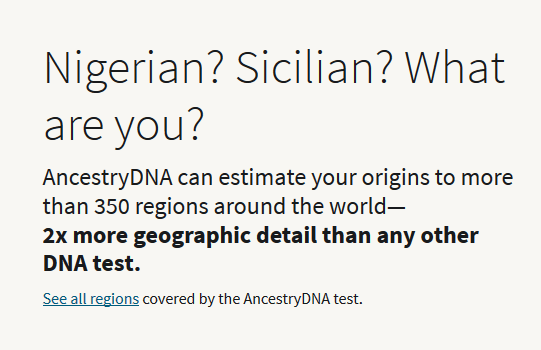
Yes! This is just what we wanted. We wanted to know “what we are”, for lack of a better term.
Where did our ancestors live? Did I have a Native American ancestor in my family tree? Did my husband have Spanish ancestors?
I should mention that when we did our test, they didn’t test for nearly as many geographic regions, but the cool thing about Ancestry is that they automatically update their users’ ethnicity results. So even though they were only testing for about 100 regions when we first tested, we can now log in to see our DNA compared with more than 1500 regions.
How do you do an Ancestry DNA test
Our kits came in the mail a few days after we ordered them. They were neatly packaged in nice little boxes:
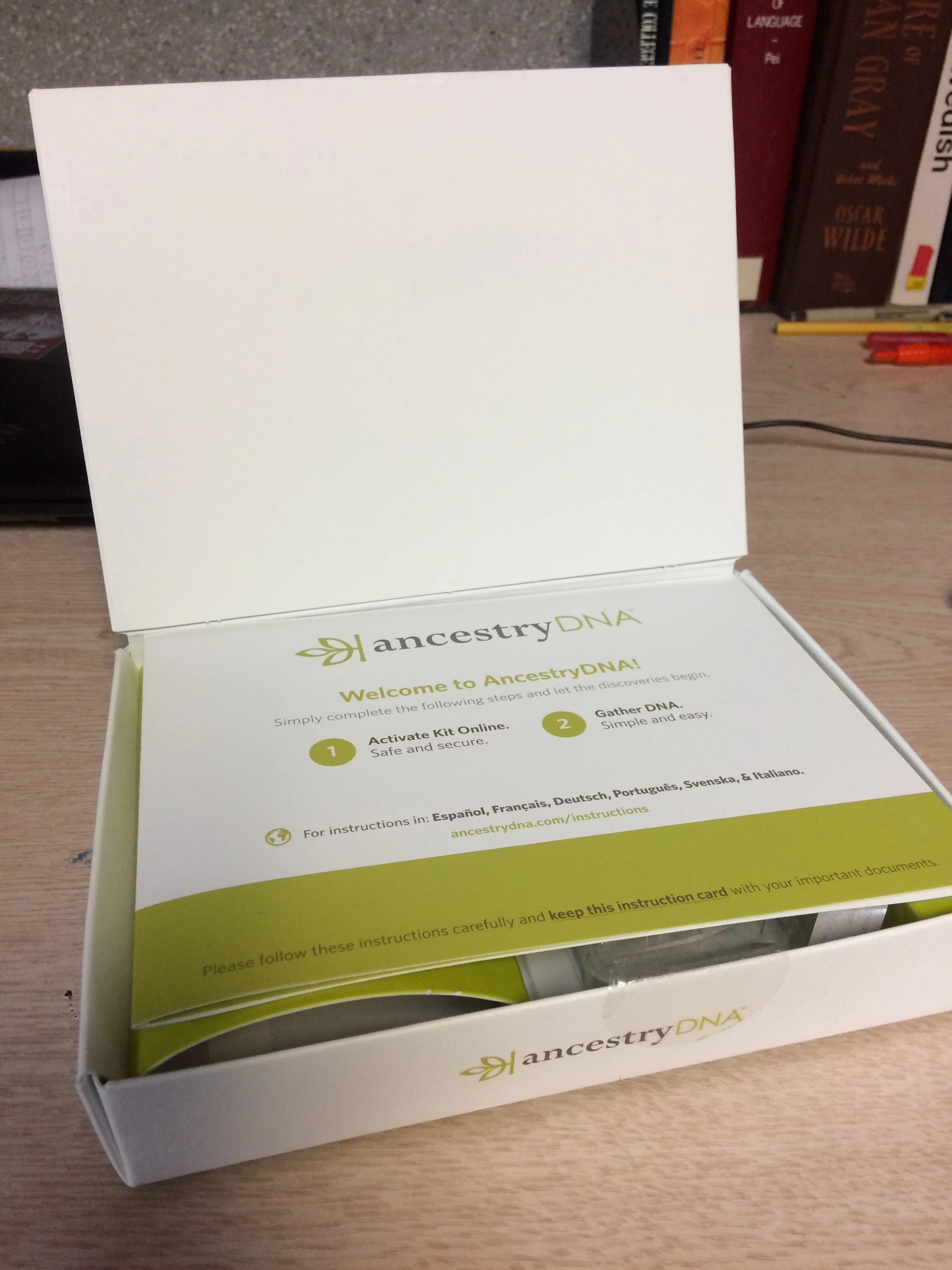
The test itself is very easy to do. There is a little vial, and you need to fill it with saliva past a little wavy mark, which is clearly marked.
Once you are done filling it, you screw on the tube tightly, which releases a stabilizing liquid. Give it a few shakes to mix the liquid with your saliva sample, slip it into the designated envelope, and you are almost done.
We had to register our kits to our Ancestry DNA account, which was pretty simple – but don’t forget to do it! It’s still done like this; I had a good friend send in their DNA test last week and they had to do a similar process.
Once you have filled the tube, put it in the envelope, and registered the kit, you can slip the sealed envelope into the postage-paid box that they provided. Close it up, pop it into the mailbox and wait.
How long does it take for Ancestry DNA results to come back?
I wasn’t prepared for how incredibly impatient I would be while waiting for my results. It took our results about 6 weeks to come back.
Sometimes tests process faster, and other times they are much closer. On average, you will probably wait 4-8 weeks from the time that you order your kit to the time that you receive the e-mail that your results are ready.
When our results were done, we got e-mails that looked like this:
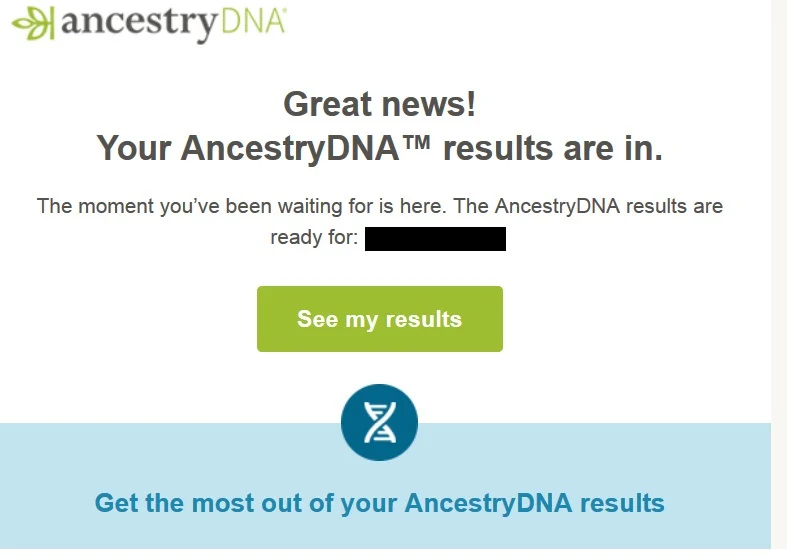
My results came back before my husband’s, even though we mailed our kits on the same day.
What did we learn from our Ancestry DNA results?
When my husband’s DNA results came back, I almost fell over. I was up early getting ready for work, and saw my husband’s results come in – I had to go get him right away.
His results?
His results now show 95% Indigenous Americas (Native American), with 1% matching Spain, Germanic Europe, Sweden and Denmark, Northern Africa, and Cyprus. His original results also had “Low Confidence Regions” which are no longer part of more recent iterations.
When he first did his test, he had a higher percentage of Irish (about 6%), but they have since adjusted this downwards, which is, theoretically, more accurate.
I was really surprised to see that he had such a high percentage of Native American ancestry. It was also a surprise to see such a low amount of Spanish DNA, since I had been under the mistaken impression that everyone from Mexico had a neat mix of Spanish and Native American roots.
It turns out that people in Mexico are very genetically diverse! We still don’t know exactly where his red hairs come from, but our theory is that it must be a stroke of mathematical luck, since his Irish and Spanish ancestors are likely very distant.
In my own results, I was disappointed to not see any obvious Native American (see my ethnicity results below), but the results did line up very well with the research that I had done on my family tree. Three of my mother’s grandparents and one of my father’s grandparents were born to Polish, Slovakian or German parents, which neatly explained my high percentage of Europe East.
My mother’s other grandparent was Irish/Scottish/English, and my father’s mother’s family comes from a family with substantial British roots, so my Great Britain and Irish seemed to line up. The mystery was, and still is, the 15% Scandinavian.
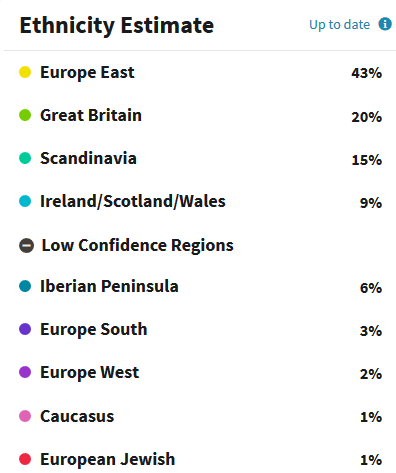
As I mentioned earlier in this review, I took my test in 2015 originally, which means that my results have changed several times since then. In my opinion, my more recent results are more accurate, yet similar to my original results.
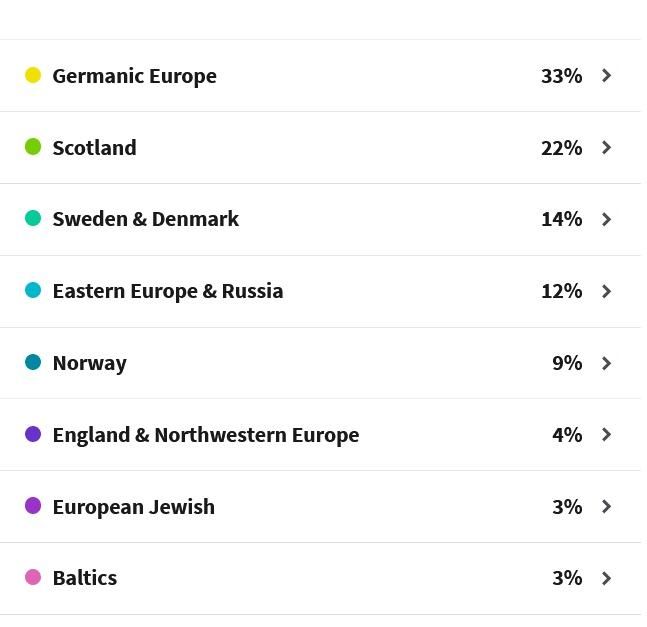
If you read about the individual ethnicity regions, you will see how the two versions of my results are not all that different. However, there is a greater degree of specificity, which I appreciate.
The mystery “Scandinavian” from my original results is still there, but it is now called “Sweden and Denmark”. I have still yet to determine exactly where in my family tree it came from .
Did Ancestry DNA help us answer our questions about our ancestry?
Yes, Ancestry DNA did answer our questions about our family’s ancestry. My husband learned that the red hairs on his beard could have come from Irish, Spanish, Scandinavian, or Germanic Europe ancestors, and I learned that I don’t have any Native American DNA.
We felt very satisfied with our DNA results.
It’s important to mention that even though our results answered our initial questions, we were actually left with many more new and exciting questions once we saw our ethnicity estimates.
For example, how did my husband inherit DNA matching the Cyprus region in the Mediterranean if he is from a small, mountainous, indigenous village in Central Mexico? Where did my European Jewish ancestry come from?
Would it be possible to find this out? How far back are these ancestors in our family trees?
Is this information accurate?
Furthermore, neither of us realized that we would be provided with a long, long list of DNA matches. People who share DNA with us, yet are perfect strangers in the most perfect sense.
This led to more questions. Who are these people?
How are they related to us? What can I learn from them? And again, is this information accurate?
Keep reading to find out!
We learned more than we bargained for with our Ancestry DNA results
I had been involved with genealogy research for a while before we did our Ancestry DNA tests, but I think it is fair to say that I was bitten by the genetic genealogy bug once we got our results back. For me personally, the DNA matches were, and continue to be, absolutely fascinating.
Ancestry DNA has the largest database of DNA test takers, and is the absolute best place to look if you are interested in finding living relatives or doing family tree research.
Yes, Ancestry DNA is accurate
My question about the accuracy of DNA matching was answered almost immediately, since I noticed my father’s first cousin on my list. He showed up as a 1st-2nd cousin, which was exactly right since he falls in the middle of that range.
There was, however, a mysterious name on my match list. It took me about two years to determine that she was my mother’s first cousin, even though she had been previously unknown to our family.
We now have a great relationship, and I feel so fortunate to have gained a new family member.
DNA matches are the most valuable aspect of the Ancestry DNA test
To answer some of those more complicated questions, such as how I inherited European Jewish ancestry, I soon learned that I would have to employ some more advanced DNA analysis techniques. They are free to do, and not too difficult to understand and use.
It turns out that you can actually download your raw DNA data from Ancestry DNA and upload it to other websites. You can get more DNA matches and access additional tools to learn more from the DNA test that you already took – how cool is that?
Some people have less DNA matches than others
My husband learned that his DNA match list is going to grow more slowly than mine. He has a lot of distant cousin matches, but fewer people who are related at a fourth cousin distance or closer.
This is likely due to the fact that he was born in another country, so many of his closer relatives have not been able to take a DNA test yet.
You already know that AncestryDNA updates ethnicity results periodically, but did you know that you will also receive new DNA matches on a regular basis as new relatives take DNA tests? Yes, it’s true.
This is why my husband’s DNA match list has grown by leaps and bounds since he first tested, and so has mine. Combined, we have tens of thousands of DNA relatives who tested their DNA with Ancestry.
Having more family members take Ancestry DNA tests teaches you even more
We both learned that it’s great to get more people in our families to do DNA testing. Since we only inherited 50% of our DNA from each of our parents, it’s a great idea to get our parents, aunts, uncles, grandparents, siblings, and close cousins to test.
Many of our important family discoveries have been made through information pieced together through DNA results from multiple family members.
Ancestry DNA also has additional features that are available to people who have a family tree on the site and have attached it to their DNA results. I didn’t really know how this would work until I tried it, but it has turned out to be a very helpful tool in understanding my results in relation to what I already knew about my family’s history:
- Shared Ancestor Hints
- DNA Circles
Through uploading my Ancestry DNA results to other websites, we were able to learn even more. I attribute these benefits indirectly to Ancestry – they still get credit for it, even if I did have to take my data somewhere else to analyze it.
Ancestry DNA results update regularly – for free!
The other great thing about Ancestry DNA is that our ethnicity results are automatically updated whenever the company develops a new technology or improves its analysis techniques. Additionally, we both get new DNA matches regularly – we now have many more than we did when we first did our tests.
For example, when I first got my results, I had only 43 DNA matches that match me at a 4th cousin level or closer, and I now have almost 800! My husband had 3, and now has 99. We both have many thousands of distant cousins as DNA matches.
Are you ready to get your Ancestry DNA test?
If you think you are ready to do an Ancestry DNA test, it would be amazing if you ordered through the following link. I’ll get a very small commission at no extra cost to you – so thank you for using the link!: Discovery the story AncestryDNA® can tell
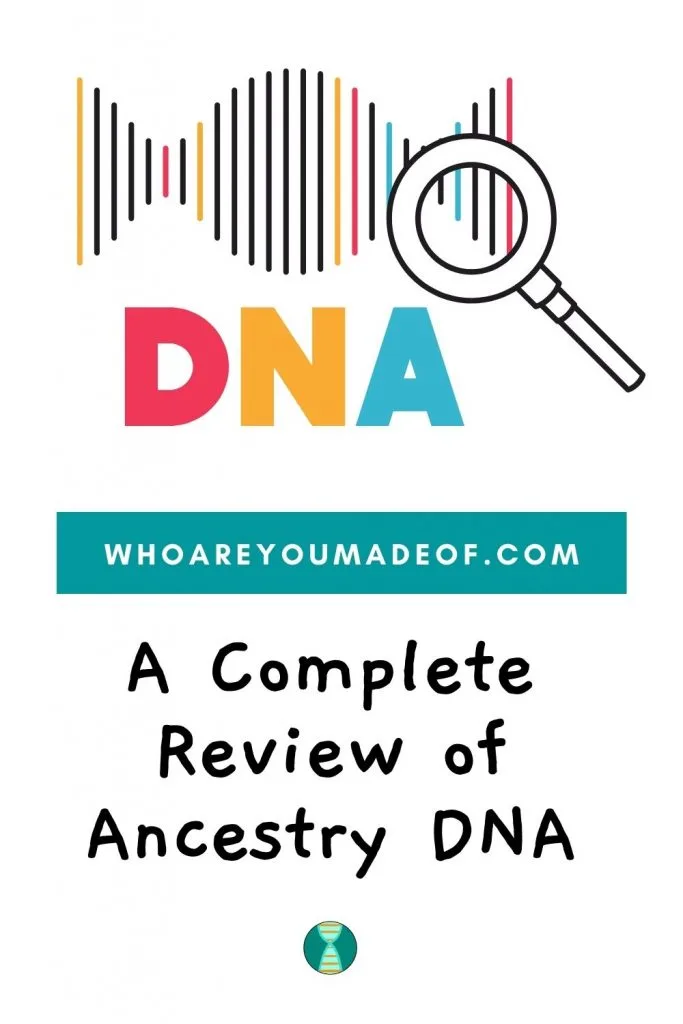
Conclusion
If you stuck with me through this whole post, you are very clearly interested in this topic. I hope you got some good insight into what you might expect from your Ancestry DNA results – I would love to hear from you in the comments if you have any questions, concerns, or would like to share your experience testing with Ancestry DNA.
Thanks for stopping by!
